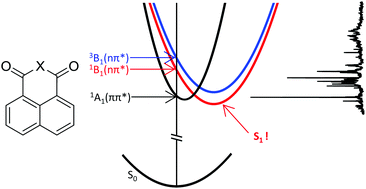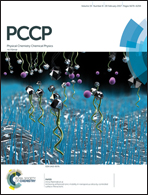Vibrationally-resolved spectroscopic studies of electronically excited states of 1,8-naphthalic anhydride and 1,8-naphthalimide: a delicate interplay between one ππ* and two nπ* states†
Abstract
The spectroscopic and dynamic properties of the lower electronically excited states of 1,8-naphthalic anhydride and 1,8-naphthalimide have been studied in supersonically cooled molecular beams using nanosecond Resonance Enhanced MultiPhoton Ionization (REMPI) spectroscopic techniques in combination with quantum chemical calculations. The excitation spectra of these compounds show near – and even below – the apparent 0–0 transition to a strongly allowed electronic state, previously assigned as the S1(21A1(ππ*)) state, a plethora of vibronic transitions that cannot simply be rationalized in terms of the Franck–Condon vibronic activity of that particular state. Instead, it is shown that the 1B1(nπ*) state, which was previously reported to be S3 for vertical excitation, is adiabatically the lowest excited singlet state. Interactions between this ‘dark’ state and the ‘bright’ 21A1(ππ*) state lead to intensity borrowing of transitions to ‘dark’ state levels that thus show up in the excitation spectra. A complicating factor is that, apart from the coupling of these two singlet states, a relatively strong spin–orbit coupling between the 21A1(ππ*) and 3B1(nπ*) states is also present. We show that the latter state has a slightly higher adiabatic excitation energy than the former state in 1,8-naphthalic anhydride but lies energetically below the 21A1(ππ*) state in 1,8-naphthalimide. Concurrently, we find that the decay dynamics of the excited states of 1,8-naphthalimide are entirely dominated by intersystem crossing, while in 1,8-naphthalic anhydride both internal conversion to the ground state and intersystem crossing occur, albeit the former loses importance once the excitation energy exceeds that of the 3B1(nπ*) state.



 Please wait while we load your content...
Please wait while we load your content...